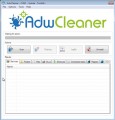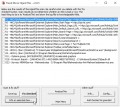The appearance of unwanted “UPDATE RECOMMENDED! Your version may be outdated” pop-up in your internet browser, that offers to update Java, means that your PC system is infected with an ad supported software. It makes changes to the system settings and configures itself so as to start automatically each time the computer is turned on. Immediately after startup, the adware begins to monitor the user’s actions and insert advertising directly into the open windows of the Google Chrome, Mozilla Firefox, Internet Explorer and Edge. So, if you notice that your browser has become show this website, then you do not need to wait, you need as quickly as possible following the few simple steps below and remove annoying pop-ups.
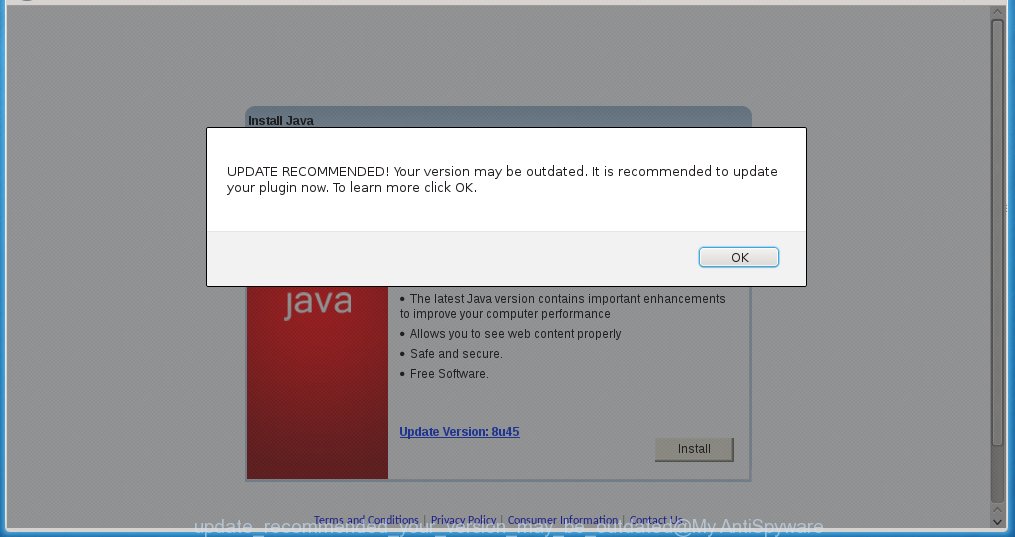
The “UPDATE RECOMMENDED! Your version may be outdated” pop-up offers to update Java
The full text of the popups is:
UPDATE RECOMMENDED! Your version may be outdated. It is recommended to update your plugin now. To learn more click OK.
Update Java - IMPORTANT!
Your Java version may be outdated. It is strongly recommended to update your Java plugin now. Upgrading to the latest Java version improves the security of your system, as older versions do not include the latest security updates.
The latest Java version contains important enhancements to improve your computer performance
Allows you to see web content properly
Safe and secure.
Free Software.
Update Version: 8u45
Most often, the ad supported software affects the most common internet browsers such as Mozilla Firefox, Internet Explorer, Google Chrome and Microsoft Edge. But such the dangerous software as well may infect another browsers (add an argument like ‘http://unwanted-site address’ into Target field of a browser’s shortcut). So every time you run the web-browser, it will redirect to an unwanted web page. Even if you setup a new start page, an annoying site will be the first thing you see when you start the Google Chrome, Mozilla Firefox, Internet Explorer and Edge.
What is more, the adware may open advertising depend on a web page that you are visiting. That is, it is clear that this ad supported software, without your permission, steals your private information such as: your ip address, what is a web page you are viewing now, what you are looking for on the Internet, which links you are clicking, and much, much more. The ad supported software may monetize its functionality by collecting data from your browsing sessions and selling it to third party companies. This puts your personal information at a security risk.
We recommend to get rid of the adware, which opens the “UPDATE RECOMMENDED!” popups within your browser, as soon as you found this problem, as it can direct you to web-resources which may load other dangerous software on your system.
How does the adware get installed onto computer
The adware usually come bundled with other free software that you download off of the Web. Once started, it will infect your PC system and configure your browser’s to show a large number of annoying popups without your permission. To avoid infection, in the Setup wizard, you should be be proactive and carefully read the ‘Terms of use’, the ‘license agreement’ and other installation screens, as well as to always choose the ‘Manual’ or ‘Advanced’ installation mode, when installing anything downloaded from the Internet.
How to manually remove “UPDATE RECOMMENDED! Your version may be outdated” popups
If you perform exactly the guide below you should be able to get rid of these popup ads. Read it once, after doing so, please print this page as you may need to close your internet browser or reboot your system.
- Get rid of suspicious and unknown software by using Windows Control Panel
- Disinfect the browser’s shortcuts
- Reset Google Chrome settings
- Reset FF settings
- Reset IE settings
Get rid of suspicious and unknown software by using Windows Control Panel
We recommend that you start the computer cleaning process by checking the list of installed programs and get rid of all unknown or suspicious applications. This is a very important step, as mentioned above, very often the malicious software such as adware and browser hijackers may be bundled with free programs. Uninstall the unwanted software may remove the unwanted ads or browser redirect to unknown or unwanted web sites.
Windows 8, 8.1, 10
Windows XP, Vista, 7
It will open the Windows Control Panel as shown below.
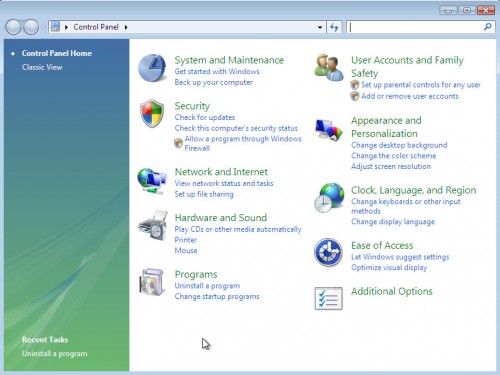
Click “Uninstall a program” ![]() It will open a list of all programs. Scroll through the all list, and get rid of any suspicious and unknown programs. To quickly find the latest installed software, we recommend sort applications by date in the Control panel.
It will open a list of all programs. Scroll through the all list, and get rid of any suspicious and unknown programs. To quickly find the latest installed software, we recommend sort applications by date in the Control panel.
Disinfect the browser’s shortcuts
Once installed, the adware may add an argument (site address) into the Target property of the desktop shortcut for the Mozilla Firefox, Internet Explorer, Google Chrome and Microsoft Edge. Due to this, every time you run the web-browser, it will be redirected to an unwanted web-site.
To cleanup a browser shortcut, right click to it and select Properties. On the Shortcut tab, locate the Target field. Click inside, you will see a vertical line – arrow pointer, move it (using -> arrow key on your keyboard) to the right as possible. You will see an argument that has been added here. Remove everything after .exe. An example, for Google Chrome you should remove everything after chrome.exe. 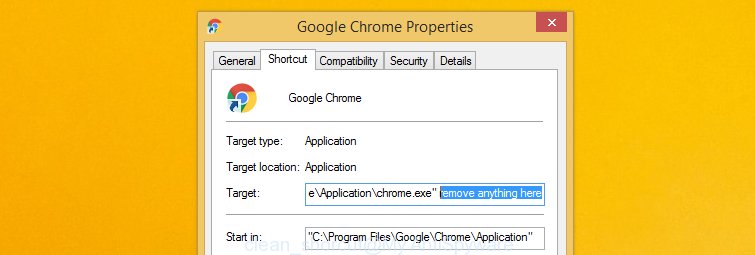 Click OK to save changes. You need to clean all internet browser’s shortcuts. So, repeat this step for the Internet Explorer, Chrome, Firefox and Microsoft Edge.
Click OK to save changes. You need to clean all internet browser’s shortcuts. So, repeat this step for the Internet Explorer, Chrome, Firefox and Microsoft Edge.
Reset Google Chrome settings
Like other modern browsers, the Google Chrome has the ability to reset the settings to their default values and thus remove the redirect to an annoying advertising which is caused by the ad supported software.
Start the Chrome. Click on the button in the form of three horizontal stripes (![]() ). It will appear the main menu. Click on the option named “Settings”. Another way to open the Google Chrome’s settings – type chrome://settings in the web-browser adress bar and press Enter.
). It will appear the main menu. Click on the option named “Settings”. Another way to open the Google Chrome’s settings – type chrome://settings in the web-browser adress bar and press Enter.  The browser will display the settings screen. Scroll down to the bottom of the page and click on the “Show advanced settings” link. Now scroll down until the “Reset settings” section is visible, as shown below and click on the “Reset settings” button.
The browser will display the settings screen. Scroll down to the bottom of the page and click on the “Show advanced settings” link. Now scroll down until the “Reset settings” section is visible, as shown below and click on the “Reset settings” button. 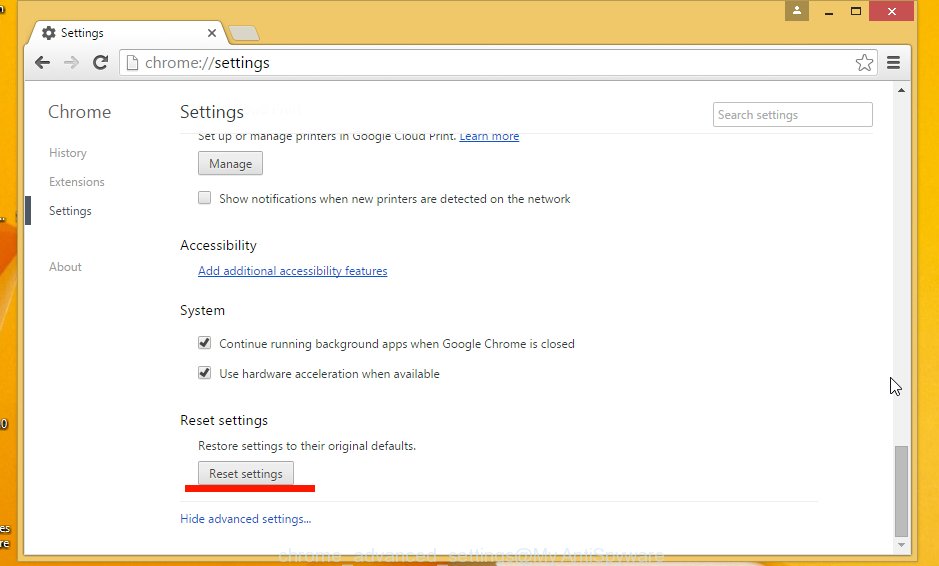 The Chrome will open the confirmation dialog box. You need to confirm your action. Press on the “Reset” button. The program will start the process of cleaning and when it is finished, the browser settings including the ‘block pop-ups’ option back to the values that have been when the Google Chrome was first installed on your PC.
The Chrome will open the confirmation dialog box. You need to confirm your action. Press on the “Reset” button. The program will start the process of cleaning and when it is finished, the browser settings including the ‘block pop-ups’ option back to the values that have been when the Google Chrome was first installed on your PC.
Reset FF settings
If the Firefox settings have been changed by the adware, then resetting it to the default state can help you to remove the redirect onto “UPDATE RECOMMENDED! Your version may be outdated” ads.
Run the Firefox and press ![]() button to open the Tools menu. It shows the drop-down menu on the right-part of the web-browser. Click on the Help button (
button to open the Tools menu. It shows the drop-down menu on the right-part of the web-browser. Click on the Help button (![]() ).
).  In the Help menu, select the “Troubleshooting Information” option. Another way to open the “Troubleshooting Information” screen – type about:support in the web-browser adress bar and press Enter. It will open the “Troubleshooting Information” page. In the upper-right corner of this screen, press the “Refresh Firefox” button.
In the Help menu, select the “Troubleshooting Information” option. Another way to open the “Troubleshooting Information” screen – type about:support in the web-browser adress bar and press Enter. It will open the “Troubleshooting Information” page. In the upper-right corner of this screen, press the “Refresh Firefox” button.  It will display the confirmation dialog box. Click on the “Refresh Firefox” button. The FF will start a task to fix your problems that caused by the adware. Once, it’s done, press the “Finish” button
It will display the confirmation dialog box. Click on the “Refresh Firefox” button. The FF will start a task to fix your problems that caused by the adware. Once, it’s done, press the “Finish” button
Reset IE settings
Open the Internet Explorer tools menu by clicking on the button in the form of gear (![]() ). It opens the drop-down menu. Click on the “Internet Options”.
). It opens the drop-down menu. Click on the “Internet Options”.  In the Internet Options window click on the Advanced tab, then click the Reset button. The Internet Explorer will show the “Reset Internet Explorer settings” window. Select the “Delete personal settings” check box, then click on “Reset” button.
In the Internet Options window click on the Advanced tab, then click the Reset button. The Internet Explorer will show the “Reset Internet Explorer settings” window. Select the “Delete personal settings” check box, then click on “Reset” button.  You will now need to restart your system for the changes to take effect.
You will now need to restart your system for the changes to take effect.
Get rid of “UPDATE RECOMMENDED! Your version may be outdated” popups with Anti-malware
Manual adware removal requires some computer skills. Some files and registry entries that created by the ‘ad-supported’ software may be not completely removed. We suggest that use the MalwareBytes Anti-malware Free that are completely clean your computer. Moreover, the free software will help you to remove malware, internet browser hijackers and toolbars that your PC may be infected too.
- Please download MalwareBytes Anti-malware to your desktop from the following link. Malwarebytes Anti-malware
327714 downloads
Author: Malwarebytes
Category: Security tools
Update: April 15, 2020
- At the download page, click on the Download button. Your internet browser will open the “Save as” prompt. Please save it onto your desktop.
- Once the download process is finished, please close all programs and open windows on your PC. Double-click on the icon that named mbam-setup.
- This will start the Setup wizard of MalwareBytes Anti-malware onto your PC system. Follow the prompts and do not make any changes to default settings.
- When the Setup wizard has finished installing, the Anti-malware will start and show the main window.
- Click on the “Scan Now” button for ad supported software removal scan. It will start scanning your PC for the adware which redirects your web-browser to the unwanted sites. This procedure can take quite a while, so please be patient.
- When the MalwareBytes Anti-malware has finished scanning, it will show a screen which contains a list of malicious software that has been found.
- When you are ready, click on “Remove Selected” button to start cleaning your computer. Once the process is done, you may be prompted to Restart.
- Close the Anti-Malware and continue with the next step.
Block unwanted popups and other malicious sites
To increase your security and protect your computer against new annoying advertisements and malicious pages, you need to use an application that blocks access to dangerous ads and web pages. Moreover, the software can block the display of intrusive advertising, which also leads to faster loading of sites and reduce the consumption of web traffic.
Download AdGuard program using the following link.
27034 downloads
Version: 6.4
Author: © Adguard
Category: Security tools
Update: November 15, 2018
After the download is complete, run the downloaded file. You will see the “Setup Wizard” screen as shown below.

Follow the prompts. After installation is complete, you will see a window as shown in the figure below.

You can click “Skip” to close the installation program and use the default settings, or press “Get Started” button to see an quick tutorial that will help you get to know AdGuard better.
In most cases, the default settings are enough and you do not need to change anything. Each time, when you start your personal computer, AdGuard will run automatically and block pop-up ads, as well as other malicious or misleading pages. For an overview of all the features of the program, or to change its settings you can simply double-click on the icon AdGuard, which is located on your desktop.
Remove “UPDATE RECOMMENDED! Your version may be outdated” ads with AdwCleaner.
If MalwareBytes Anti-malware cannot remove the annoying advertising within the Google Chrome, Mozilla Firefox, Internet Explorer and Edge, then we suggests to use the AdwCleaner. AdwCleaner is a free removal tool for adware, browser hijackers, PUPs, toolbars. Also you can ask for help our Myantispyware team below.
Download AdwCleaner from the link below.
225786 downloads
Version: 8.4.1
Author: Xplode, MalwareBytes
Category: Security tools
Update: October 5, 2024
Once finished, open a directory in which you saved it. You will see a icon like below.
Double click the AdwCleaner desktop icon. Once this tool is started, you will see a screen like below.
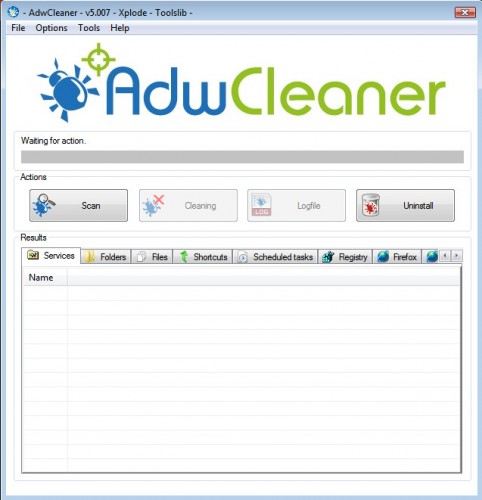
Press “Start” button to perform a system scan for malicious extensions and the adware which displays the unwanted advertisements. Once AdwCleaner has finished, it will open a scan report as shown below.

Review the report and then click “Cleaning” button. It will display a prompt.

Click “OK”. When the cleaning process is finished, AdwCleaner may ask you to reboot your personal computer.
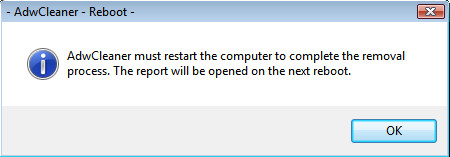
When your PC system is started, you will see an AdwCleaner log.

How to ask for help the Myantispyware team
If you are seeking a help for adware removal then follow these steps.
- Download HijackThis from the link below and save it to your Desktop. HijackThis download
5310 downloads
Version: 2.0.5
Author: OpenSource
Category: Security tools
Update: November 7, 2015
- Double-click on the HijackThis icon, and click the button labeled “Do a system scan only”.
- Once the scan is complete, the scan button will read “Save log”, click it. Save this log to your desktop
Create a Myantispyware account here. Once you’ve registered, check your e-mail for a confirmation link, and confirm your account. After that, login.
- Copy and paste the contents of the HijackThis log into your post. If you are posting for the first time, please start a new thread by using the “New Topic” button in the Spyware Removal forum. When posting your HJT log, try to give us some details about your problems, so we can try to help you more accurately.
- Wait for one of our trained “Security Team” or Site Administrator to provide you with knowledgeable assistance tailored to your problem with the unwanted “UPDATE RECOMMENDED! Your version may be outdated” popups.

